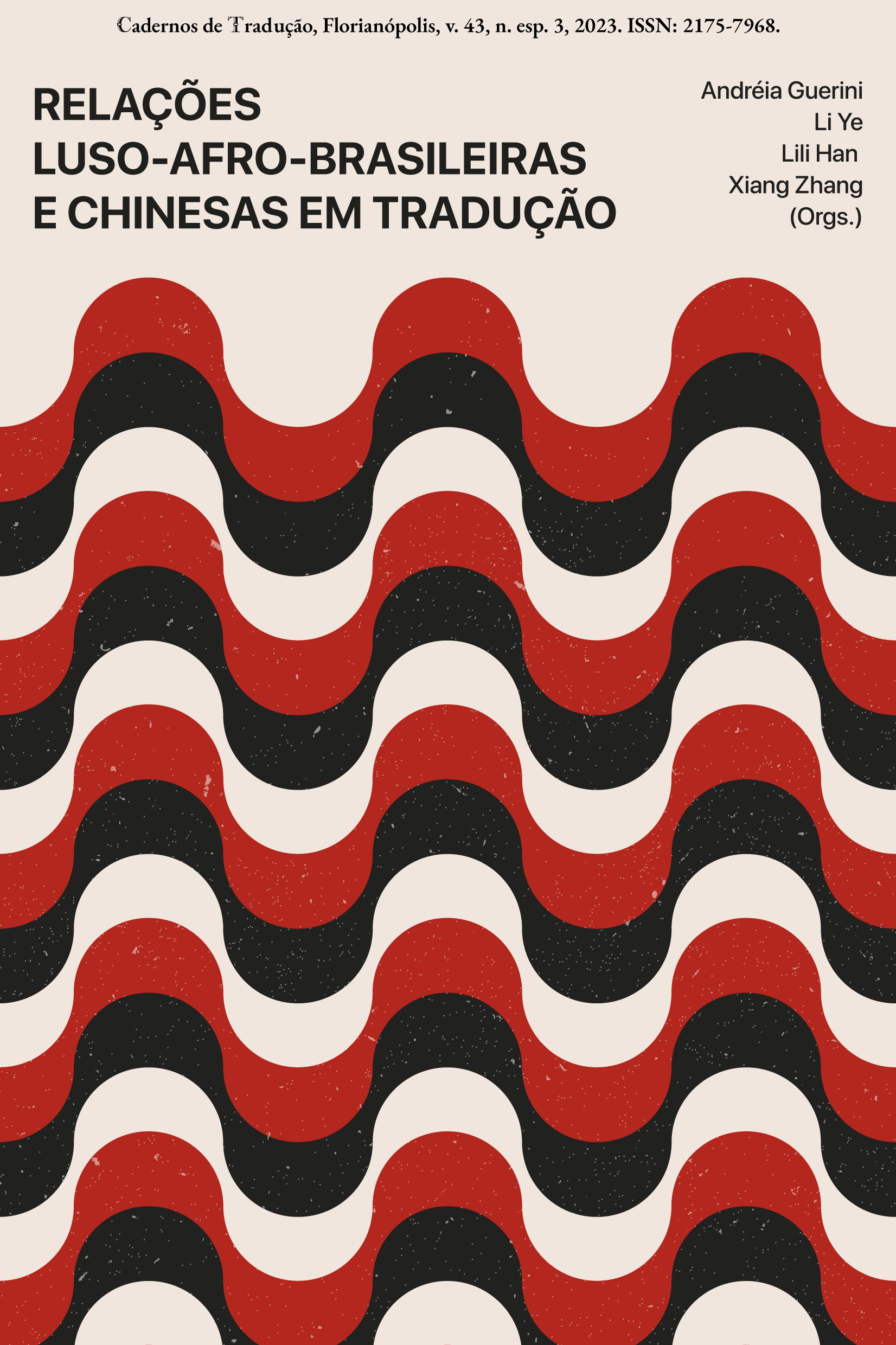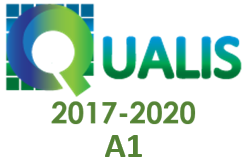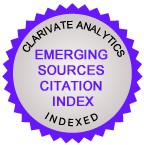On the translation of the Chinese structure “bu (mei) + verb” into Portuguese based on a Chinese-Portuguese parallel corpus
DOI:
https://doi.org/10.5007/2175-7968.2023.e87041Keywords:
Negative adverb “bu”, Negative adverb “mei”, Translation, Parallel corpus, ChineseAbstract
This study aims to analyse the possible translation tendencies of the structure “bu (mei) + verb” from Chinese to Portuguese. In modern Chinese, the two negative adverbs “bu” and “mei” have a very close relationship with the aspect of postponed verbs, that is, as Chinese verbs are not conjugated, these two negative adverbs associate the verbs to different aspects (the adverb “bu” links the postponed verb to the imperfect aspect, and the adverb “mei”, to the perfect aspect). To verify whether the Portuguese translations of such adverbs also obey this relationship, we use a parallel Chinese-Portuguese corpus, whose design is based on a work by Mo Yan, Chinese writer, and its Portuguese translation by Amilton Reis. By examining the extracted bilingual examples, we sought to analyse and discuss the possible tendencies in the translation of the structure “bu (mei) + verb” into Portuguese, in the hope of helping translators in training to understand and master the translation tendencies of this structure.
References
Bai, Quan. “Misunderstandings in Teaching and Research of “bu” and “mei (you)” - Discussion on the Meaning and Usage of “bu” and “mei (you)”” [“不”、“没(有)” 教学和研究上的误区-关于“不”、“没(有)”的意义和用法的探讨]. Language Teaching and Linguistic Studies [语言教学与研究]. 03, p. 21-25, 2000.
Barreto, Cristiano Mahaut de Barros. “Menina Acanhada: uma Tradução do shījīng”. Cadernos de Tradução, 2(28), p. 181-200, 2011. DOI: https://doi.org/10.5007/2175-7968.2011v2n28p181
Bernardini, Silvia. “Discovery learning in the language-for-translation classroom: corpora as learning aids”. Cadernos de Tradução, 36(1), p. 14-35, 2016. DOI: https://doi.org/10.5007/2175-7968.2016v36nesp1p14
Cunha, Celso Ferreira da & Cintra, Luís Filipe Lindley. Nova Gramática do Português Contemporâneo. 7. ed. Rio de Janeiro: Lexikon, 2016.
Escaleira, Maria de Lurdes Nogueira. “O Que é Preciso para Ser Tradutor?: Estudo de Caso–Macau (China)”. Cadernos de Tradução, 36(2), p. 180-204, 2016. DOI: https://doi.org/10.5007/2175-7968.2016v36n2p180
Frérot, Cécile. “Corpora and Corpus Technology for Translation Purposes in Professional and Academic Environments. Major Achievements and New Perspectives”. Cadernos de Tradução, 36(1), p. 36-61, 2016. DOI: https://doi.org/10.5007/2175-7968.2016v36nesp1p36
Jatobá, Júlio Reis. “Poéticas do Traduzir a, na e para a China: uma Proposta”. Cadernos de Tradução, 39(esp.), p. 120-147, 2019. DOI: https://doi.org/10.5007/2175-7968.2019v39nespp120
Lang, Sida & Sun, Yuqi. “Estranhamento como Estratégia de Tradução: Categorização do Estranhamento na Poesia Leminskiana e a sua Recriação na Língua Chinesa”. Cadernos de Tradução, 40(3), p. 154-186, 2020. DOI: https://doi.org/10.5007/2175-7968.2020v40n3p154
Li, Changsen. Aspectos Teórico-Práticos de Tradução – Portuguê/Chinês [实用葡汉翻译教程]. Macau: Instituto Politécnico de Macau [澳門理工学院], 2002.
Li, Ye. “Sobre os Métodos da Tradução de Livros Literários”. Cadernos de Tradução, 39(2), p. 379-388, 2019. DOI: https://doi.org/10.5007/2175-7968.2019v39n2p379
Lu, Jing; Han, Lili & André, Carlos Ascenso. “Tradução Portuguesa de Referências Culturais Extralinguísticas no Manual de Chinês Língua Não Materna: Aplicação de Estratégias de Tradução Propostas por Andrew Chesterman”. Cadernos de Tradução, 42(1), p. 1-39, 2022. DOI: https://doi.org/10.5007/2175-7968.2022.e82416
Lu, Xiuzhen. Misusage of Chinese Negative Adverbs By Korean High School Students and Consideration for Developing Alternative Teaching Methods [韩国高中生习得汉语“不”和“没”否定结构的偏误分析和教学对策]. Dissertation (Master of Teaching Chinese to Speakers of Other Languages), College of International Education, Shandong University, Jinan, 2013.
Lv, Shuxiang. 800 Words in Modern Chinese [现代汉语八百词]. Beijing: Commercial Press [商务印书馆], 1999.
Maia, Belinda. “Do-It-Yourself, Disposable, Specialised Mini Corpora–Where Next? Reflections on Teaching Translation and Terminology through Corpora”. Cadernos de Tradução, 1(9), p. 221-236, 2002. DOI: https://doi.org/10.5007/%25x
Mo, Yan. Mudança [变]. Beijing: Dolphin Press [海豚出版社], 2010.
Mo, Yan. Mudança. Tradução de Amilton Reis. Publicado em acordo com a Seagull Books. São Paulo: Cosac Naify, 2013.
Sánchez Nieto, María Teresa. “Learner Corpora, Corpora of Professional Translations and Creative Writing in a Course on Translation of General Texts: an Action Research Project”. Cadernos de Tradução, 36(1), p. 121-146, 2016. DOI: https://doi.org/10.5007/2175-7968.2016v36nesp1p121
López Rodríguez, Clara Inés. “Using Corpora in Scientific and Technical Translation Training: Resources to Identify Conventionality and Promote Creativity”. Cadernos de Tradução, 36(1), p. 88-120, 2016. DOI: https://doi.org/10.5007/2175-7968.2016v36nesp1p88
Tagnin, Stella Esther Ortweiler. “Os Corpora: instrumentos de auto-ajuda para o tradutor”. Cadernos de Tradução, 1(9), p. 191-219, 2002.
Vinay, Jean-Paul., & Darbelnet, Jean. Comparative stylistics of French and English: a methodology for Translation. Amsterdã & Filadélfia: John Benjamins Publishing. The original French version Stylistique comparée du français et de l’anglais: Méthode de traduction was published in 1958, Paris: Didier, 1995.
Wang, Chengxu. “Análise da tradução do poema O Velho Carvoeiro sob a perspetiva da linguística sistémico-funcional”. Cadernos de Tradução, 42(1), p. 1-35, 2022. DOI: https://doi.org/10.5007/2175-7968.2022.e83708
Ye, Li. “Novamente sobre a tradução: uma resposta a Lu Xun”. Cadernos de Tradução, 41(1), p. 378-389, 2021. DOI: https://doi.org/10.5007/2175-7968.2021.e78727
Zhang, Jianbo & Lou, Zhichang. “Tradução das palavras com carga cultural no romance 活着 (Huó Zhe, Viver) a partir da perspectiva da eco-translatologia”. Cadernos de Tradução, 1(43), p. 1-22, 2023. DOI: https://doi.org/10.5007/2175-7968.2023.e86532
Zhang, Tao; Wen, Xu & Humblé, Philippe. “An RCG-Based Analysis of the Translation of Polysemous ‘Yao’ in A Dream of Red Mansions”. Cadernos de Tradução, 42(1), p. 1-22, 2022. DOI: https://doi.org/10.5007/2175-7968.2022.e84498
Zhao, Shiyu. Comparación Bilingüe entre Chino e Español [汉语、西班牙语双语比较]. Beijing: Foreign Language Teaching and Research Press [外语教学与研究出版社], 1998.
Zhao, Shiyu. Nuevo Curso de Traducción del Chino al Español [新编汉西翻译教程]. Beijing: Foreign Language Teaching and Research Press [外语教学与研究出版社], 1999.
Zhao, Ziwei. “mingbai” and “zhidao”: Contrast Analysis and Teaching Chinese as a Foreign Language Strategy [“明白”和“知道”的对比分析及对外汉语教学策略]. Dissertation (Master of Teaching Chinese as a Foreign Language), College of Humanities, Jilin University, Changchun, 2017.
Zhu, Dexi. On Chinese Grammar [语法讲义]. Beijing : Commercial Press [商务印书馆], 1982.
Zhu, Kai. Curso de Traducción del Español al Chino: Teoría y Práctica [西汉翻译理论与实践]. University of International Business and Economics Press [对外经贸大学出版社], 2013.
Downloads
Published
How to Cite
Issue
Section
License
Copyright (c) 2023 Cadernos de Tradução

This work is licensed under a Creative Commons Attribution 4.0 International License.
Copyright Notice
Authors hold the copyright and grant the journal the right for their articles' first publication, being their works simultaneously licensed under the Creative Commons Attribution License (CC BY), which allows the sharing of such works with its authorship acknowledged and its initial publication in this journal.
Authors are allowed to enter into separate additional contractual arrangements for the non-exclusive distribution of the journal's published version of the work (e.g., post it to an institutional repository or as a book chapter, with an acknowledgment of its initial publication in this journal).






















































